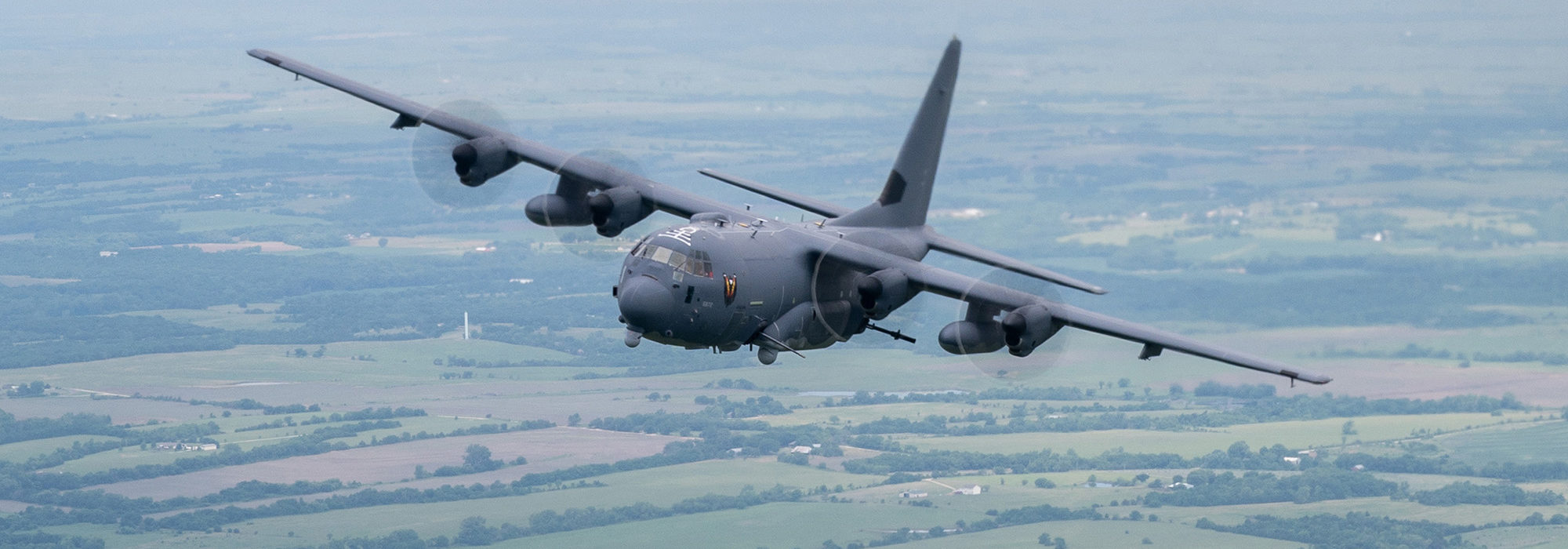By Greg Hadley
Lockheed Martin has completed factory acceptance testing and delivered a new laser weapon to the Air Force, the defense contractor announced Oct. 6, with the goal of mounting it on the AC-130J gunship.
“Completion of this milestone is a tremendous accomplishment for our customer,” said Rick Cordaro, vice president for Lockheed Martin Advanced Product Solutions, in a press release. “These mission success milestones are a testament of our partnership with the U.S. Air Force in rapidly achieving important advances in laser weapon system development. Our technology is ready for fielding today.”
The Airborne High Energy Laser (AHEL) has been in development at Lockheed Martin since at least 2019, when the company received a contract for integration, testing, and demonstration of such a weapon on the AC-130J aircraft.
Air Force leaders, however, have been talking about the possibility of a laser weapon onboard the AC-130J Ghostrider for much longer than that.
Back in 2015, then-Air Force Special Operations Command boss Lt. Gen. Bradley A. Heithold issued a challenge—to get a high-powered laser onboard the AC-130J by the end of the decade. That timeline was later pushed back to 2022 by Heithold’s successor, Lt. Gen. Marshall B. “Brad” Webb.
What capabilities the AHEL will bring to the AC-130J remain to be seen. Lockheed Martin claims that its spectrally combined fiber laser weapon systems—of which AHEL is one—are “ready to defend against small rockets, artillery shells and mortars, small unmanned aerial vehicles, small attack boats, and lightweight ground vehicles that are approximately a mile away,” according to the company’s website, which also features an image of a hole smoldering in the hood of a pickup.
A Lockheed Martin spokesperson said “the specific capabilities of the AHEL laser cannot be discussed at this time” and deferred questions to the Naval Surface Warfare Center’s Dahlgren Division, which gave Lockheed Martin a $12 million, five-year contract award in July 2021 for technical services, integration, testing, and demonstration of the AHEL. The Dahlgren Division subsequently deferred comment to Air Force Special Operations Command.
In 2015, Heithold described the laser weapon as primarily for protection from surface-to-air attacks, as modern threats reduced the windows in which the aircraft could operate.
Webb, however, envisioned it as an offensive capability, too, being used to disable enemies’ communications, transportation, and power supply, according to National Defense Magazine.
In its press release, Lockheed Martin said it has delivered the AHEL for integration with other systems before ground testing and “ultimately flight testing aboard the AC-130J aircraft.” The contractor added that it is on a “rapid schedule” to demonstrate the weapon on the AC-130J.
The AC-130J is used for close air support, air interdiction, and armed reconnaissance, and already features 30 mm and 105 mm cannons, precision-guided missiles, and small-diameter bombs.
Air Force Activates First F-35 Squadron in Europe
By Greg Hadley
The Air Force activated its first squadron of Europe-based F-35As at RAF Lakenheath, U.K., on Oct. 1, as the service prepares to deliver the first fighters in the coming months.
The 495th Fighter Squadron was activated exactly 30 years after it was designated as a fighter squadron in 1991. Just a few months after that, though, the squadron was inactivated.
In 2015, the Air Force announced that Lakenheath would be the first base in Europe to get the new F-35 fighter, and in September 2020, U.S. Air Forces in Europe announced it was reactivating the 495th under the 48th Fighter Wing.
The 495th will consist of 27 F-35s and around 60 personnel, according to a 48th Fighter Wing release announcing the squadron’s activation. The Air Force plans to eventually base a total of 48 F-35s at Lakenheath in two squadrons.
The first F-35s were originally slated to arrive in Europe in 2020, but construction delays bumped the activation to 2021.
Lt. Col. Ian D. McLaughlin assumed command of the 495th on Oct. 1. The squadron will be nicknamed the Valkyries, after the female figures in Norse mythology who choose who will live or die in battle.
The F-35s are set to start arriving in December.
With American F-35s arriving in Europe for the first time, the Air Force will be able to integrate and operate with its partners in the region, who also operate the F-35, like never before, USAFE commander Gen. Jeffrey L. Harrigian said at the Air Force Association’s September conference.
“We’ve already got some pretty good plans as we start thinking about how we leverage that capability, particularly with many of our partners that already have F-35s in the theater. I really think it’ll be a truly important step as we continue to demonstrate the importance that the F-35 has baked into it from an interoperability perspective,” Harrigian said.
A number of American allies and partners have already received F-35s from Lockheed Martin, including the United Kingdom, Norway, Italy, the Netherlands, Denmark, and Israel. Switzerland announced in June that it would buy the stealth fighter as well.
NATO Supreme Allied Commander Air Force Gen. Tod D. Wolters, speaking at an event in June, predicted that between the U.S. and its allies and partners, there will be 450 F-35s in Europe by 2030.
